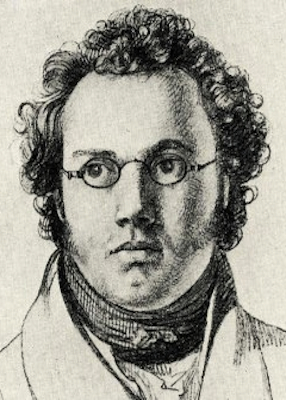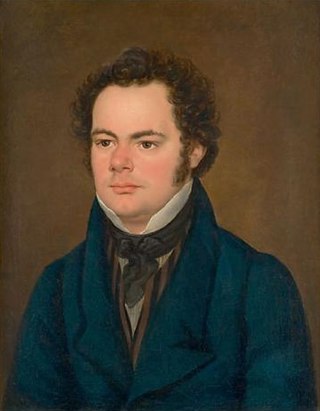External links
- String Quartet No. 9 : Scores at the International Music Score Library Project
| Duos | |
|---|---|
| Trios | |
| String Quartets | |
| Other | |
| National | |
|---|---|
| Other | |
The String Quartet No. 9 (D 173) in G minor was composed by Franz Schubert in 1815.

The Trout Quintet (Forellenquintett) is the popular name for the Piano Quintet in A major, D. 667, by Franz Schubert. The piano quintet was composed in 1819, when he was 22 years old; it was not published, however, until 1829, a year after his death.
The String Quartet No. 15 in G major, D. 887, was the last quartet written by Franz Schubert in June 1826. It was posthumously published in 1851, as Op. 161. The work focuses on lyrical ideas and explores far-reaching major and minor modes, which was uncommon to this degree in his compositions. Schubert reinforced this with a range of dynamic contrast and use of texture and pizzicato. The structural form of the movements in this quartet are somewhat ambiguous due to Schubert's focus on lyricism rather than traditional harmonic structure.

Robert David Levin is an American classical pianist, musicologist, and composer who served as the artistic director of the Sarasota Music Festival from 2007 to 2017.

Franz Schubert's final chamber work, the String Quintet in C major is sometimes called the "Cello Quintet" because it is scored for a standard string quartet plus an extra cello instead of the extra viola which is more usual in conventional string quintets. It was composed in 1828 and completed just two months before the composer's death. The first public performance of the piece did not occur until 1850, and publication occurred three years later in 1853. Schubert's only full-fledged string quintet, it has been praised as "sublime" or "extraordinary" and as possessing "bottomless pathos," and is generally regarded as Schubert's finest chamber work as well as one of the greatest compositions in all chamber music.

The String Quartet No. 13 in A minor, D 804, Op. 29, was written by Franz Schubert between February and March 1824. It dates roughly to the same time as his monumental Death and the Maiden Quartet, emerging around three years after his previous attempt to write for the string quartet genre, the Quartettsatz, D 703, that he never finished.

The Quartettsatz c-Moll D 703 was composed by Franz Schubert in December 1820 as the first movement, Allegro assai, of a string quartet he was never to complete. Upon publication it was nonetheless listed as his "String Quartet No. 12". The nine-minute work is regarded as an early product of the composer's mature phase of output.

Franz Schubert wrote three string trios, all of them in the key of B-flat major. From the first of these, D 111A, a trio Schubert wrote in 1814, only a few measures are extant. The string trio D 471 consists of a completed first movement and an incomplete second movement, composed in 1816. The last of these trios, D 581, was completed in four movements, exists in two versions and was composed in 1817.
Sonatas, duos and fantasies by Franz Schubert include all works for solo piano by Franz Schubert, except separate dances. They also include a number of works for two players: piano four hands, or piano and a string instrument.
The String Quartet No. 1 in mixed keys was composed by Franz Schubert in 1810 or 1811.
The String Quartet No. 2 in C major was composed by Franz Schubert in 1812.
The String Quartet No. 3 in B-flat major was composed by Franz Schubert in 1813.
The String Quartet No. 4 in C major was composed by Franz Schubert in 1813.
The String Quartet No. 5 in B-flat major was composed by Franz Schubert in 1813.
The String Quartet No. 6 in D major was composed by Franz Schubert in 1813.
Franz Schubert composed his String Quartet No. 10 in E-flat major in 1813.
The String Quartet No. 7 in D major was composed by Franz Schubert in 1811 or 1812.
The String Quartet No. 8 in B-flat major was composed by Franz Schubert in 1814. It was posthumously published as Op. 168.
The String Quartet No. 11 in E major was composed by Franz Schubert in 1816. It was posthumously published as Op. 125 No. 2.
From March 1816 to August 1817, Franz Schubert composed four violin sonatas. All four were published after the composer's death: the first three, D 384, 385 and 408, as Sonatinas in 1836, and the last one, D 574, as Duo in 1851. Schubert composed two more pieces for violin and piano, in October 1826 and December 1827 respectively: a Rondo, D 895, which was published during the composer's lifetime (Op. 70), and a Fantasy, D 934, which was premiered in January 1828, less than a year before the composer's death.
In 1816, Franz Schubert composed his first three violin sonatas, D 384, 385 and 408. They were published after the composer's death as Sonatinas in 1836. These sonatas breathe an intimate atmosphere, requiring relatively little virtuoso bravura from their performers.